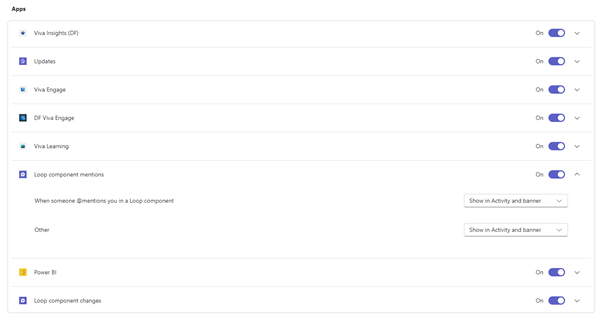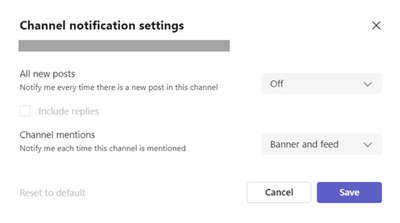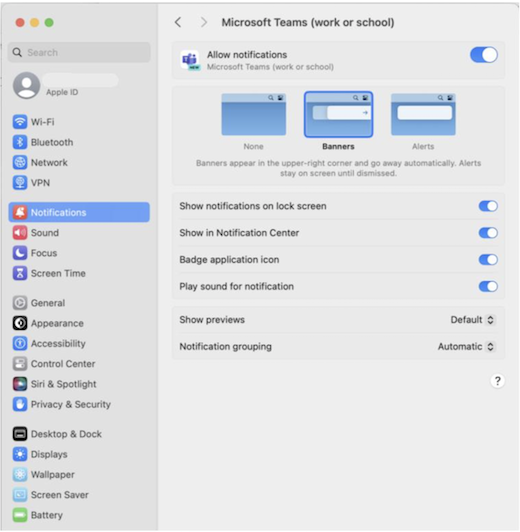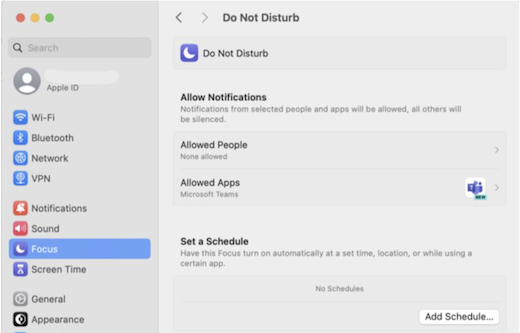
Microsoft Teams offers different ways to access, receive, and manage notifications. These settings include how, when, and where your notifications appear, custom settings for channels and chat, appearance and sounds, turning off specific messages, and so on.
To manage your notifications, select Settings and more

at the top right of Teams, then select Settings

> Notifications and activity

In the General section of Notifications and activity you can configure notifications in several important ways, ensuring that Teams is providing you with the level of notifications and reminders that works best for you.
In the General section, you have several options to configure and customize sounds. You can also change when you want notifications to display. Your options include:
You can adjust the sound of your Teams notifications to help you prioritize tasks and stay focused. Choose to assign different sounds to different kinds of notifications, or mute notifications when you're busy or in a meeting.
In the Sound section of Notifications and activity, you'll see dropdown menus next to the first two notification items. Select a sound from the dropdown menu, then select Play

to preview the sound.
Simply select your preferred sounds for Play sounds with notifications and Play sounds for urgent and priority contact notifications, and you're all set.
Note: Custom sounds are currently available only on Teams for Windows and web.
In the Missed activity emails section, you’re able to set the frequency of summary emails detailing your missed activity, or turn this feature off.
Notifications for chats and channels can be managed at a granular level, allowing you to customize your notifications to your personal work style. In the Chats and channels sections of Notifications and activity, you can do the following:
In the Meetings section of Notifications and activity, you can configure how notifications are shown for meeting about to start, and chat notifications during meetings.
Keep track of the status of your colleagues and contacts, and get notified when they appear available or offline.
In the Calendar section of Notifications and activity, you can configure how notifications are shown for new meeting invites on your calendar, updates, cancellations, and when meetings you’ve organized have been forwarded to others.
Individual apps (such as Power BI, Loop, and more) can be added to teams, and notifications can be managed and configured for each of these apps.

Note: The Apps section will not display until individual apps have been added to Teams, and you have received your first app notification.
Hover on a channel in your Teams list and select More options

> Channel notifications

For each channel you can configure notifications in two ways:
Note: By default, channel new post notifications are turned off, and @mentions will show in both Banner and feed. To return to default settings, select Reset to default.

Go to Activity

on the left side of Teams, and select More options

. Select Notification settings

You will see the Settings > Notification and activity screen as described previously in the article.
Microsoft Teams notifications on MacOS provide a seamless experience for calls, meetings, chats, channels, mentions, and apps within Teams. However, there are some differences compared to Windows due to the rich integration with the macOS notifications system.

To learn more about how MacOS notifications work and how to change Notifications settings, refer to the MacOS user guide section Change Notifications settings on Mac. Make sure to select your OS version from the dropdown menu.
When you connect your Mac to an external display or dock station, by default all notifications will land in the Mac Notifications center only. If you want to receive Teams banner notifications as well:
To learn more about pausing or allowing notifications when you mirror or share the display (for example, when playing a presentation), refer to MacOS user guide section Extend or mirror your Mac desktop across multiple displays. Make sure to select your OS version from the dropdown menu.
If you want to receive Teams notifications even when Do Not Disturb is active, add Teams to Allowed Apps. Please note that you need to take this step individually for each Focus scenario.

For more details on Focus options in macOS, refer to the MacOS user guide section Change Focus settings on Mac. Make sure to select your OS version from the dropdown menu.
Once notifications are allowed and configured at the operating system level, you can fine-tune Teams notification settings directly within the app to receive the notifications you need.
To customize your notifications, tap your profile picture at the top left of the mobile app, then select Notifications. To troubleshoot notification issues on mobile, see Troubleshoot notifications for Teams mobile apps.
To customize your notifications, tap your profile picture at the top left of the mobile app, then select Notifications. To troubleshoot notification issues on mobile, see Troubleshoot notifications for Teams mobile apps.